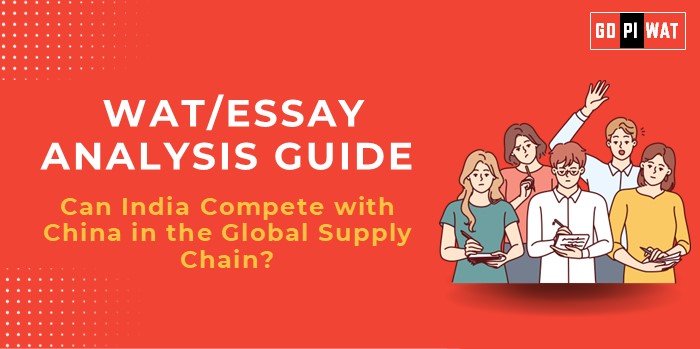📋 WAT/Essay Analysis Guide
⚙️ Can India Compete with China in the Global Supply Chain?
🌟 Understanding the Topic’s Importance
The topic is crucial for understanding India’s role in global trade and manufacturing, a key focus for policymakers and businesses alike. It explores how India can harness its demographic dividend, government initiatives, and global trends to strengthen its supply chain position.
📝 Effective Planning and Writing
- ⏱️ Time Allocation:
- Planning: 5 minutes
- Writing: 20 minutes
- Review: 5 minutes
- ✍️ Word Count Distribution:
- Introduction: 60–70 words
- Body: 350–375 words
- Conclusion: 60–70 words
💡 Introduction Techniques for Essays
-
- Contrast Approach:
“China’s 28% share in global manufacturing far exceeds India’s 3%. Yet, geopolitical shifts and policy reforms present a unique opportunity for India to position itself as an alternative in the global supply chain.”
-
- Opportunity-Based:
“With rising US-China trade tensions and a growing demand for diversified supply chains, India’s manufacturing sector stands at a crossroads. Can it seize this moment to emerge as a global leader?”
🔍 Structuring the Essay Body
🏆 Achievements:
- 📈 PLI Schemes: Boosting sectors like electronics, auto components, and pharmaceuticals; attracting companies like Foxconn and Apple.
- 📊 Improved Trade Metrics: Electronics exports increased by 49% in FY 2022–23, reaching $23.57 billion.
- 🏗️ Infrastructure Projects: Industrial corridors (Delhi-Mumbai) and Sagarmala are improving connectivity and enhancing supply chain efficiency.
⚠️ Challenges:
- 🚛 Infrastructure Gaps: India ranks 44th on the Logistics Performance Index, highlighting issues in transport and logistics.
- 📜 Policy Hurdles: Complex regulations often deter foreign investors.
- 🎓 Skilled Workforce: While India has a youthful workforce, a lack of specialized skills limits competitiveness in advanced manufacturing.
🔮 Future Outlook:
- 📡 5G and Technology Integration: Adoption of Industry 4.0 and AI-driven supply chain optimization can enhance efficiency.
- 🤝 Global Partnerships: Strengthening trade agreements can attract more foreign investment.
- 🌿 Sustainability Focus: Adopting green manufacturing practices aligns India with global trends and makes its supply chain more competitive.
📄 Concluding Effectively
-
- Balanced Conclusion:
“While India has demonstrated significant progress in its supply chain initiatives, addressing infrastructure and skill development gaps remains critical for long-term success.”
-
- Future-Focused Conclusion:
“As India aligns its policies and investments with global trends, its potential to emerge as a credible competitor to China depends on leveraging its demographic advantage and enhancing manufacturing capabilities.”
✨ Recommendations for Sustainable Progress
- 🏗️ Infrastructure Development: Accelerate projects like Bharatmala and Sagarmala to improve connectivity and logistics efficiency.
- 🎓 Skill Development: Invest in vocational training and industry-relevant education programs to upskill the workforce.
- 📜 Policy Simplification: Streamline regulations to create a more business-friendly environment.
📊 Advanced Writing Techniques
🔍 PESTLE Analysis:
- 🗳️ Political: Stable policies to attract investments.
- 📈 Economic: Boost exports through PLI schemes.
- 👨👩👦 Social: Leverage demographic dividend.
- 🤖 Technological: Invest in automation and AI.
- ⚖️ Legal: Simplify compliance frameworks.
- 🌿 Environmental: Green manufacturing initiatives.
🛠️ SWOT Matrix:
- 💪 Strengths: Young workforce, policy incentives.
- 🔧 Weaknesses: Infrastructure deficits, skill gaps.
- 🌐 Opportunities: Geopolitical shifts, trade diversification.
- ⚠️ Threats: Competition from Vietnam, regulatory delays.
📝 Sample Short Essays (100 Words Each)
📌 Balanced Perspective:
“India’s burgeoning manufacturing sector, backed by initiatives like the PLI scheme, has demonstrated remarkable progress. However, infrastructure gaps and regulatory hurdles persist. By addressing these challenges, India can better position itself in the global supply chain.”
📌 Solution-Oriented:
“To compete with China, India must focus on infrastructure, skill development, and policy reform. Strategic investments and partnerships can help India build a robust and sustainable manufacturing ecosystem.”
📌 Global Comparison:
“China’s dominance in manufacturing is unmatched, but India’s emerging capabilities offer a promising alternative. With strategic reforms and infrastructure investments, India can capitalize on global trends to gain a competitive edge.”


